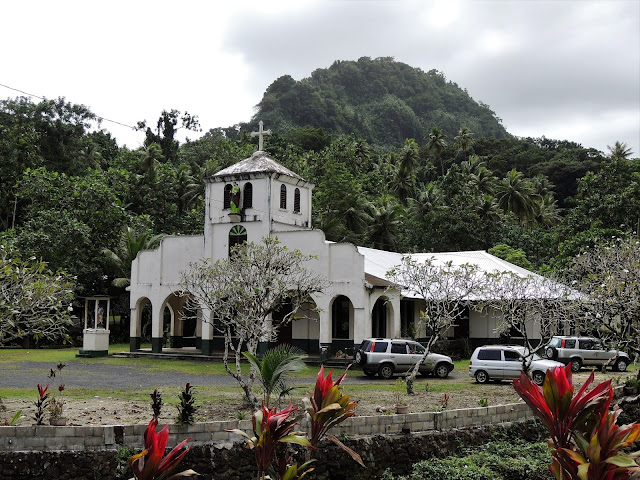Just before we let for
Kosrae we again took advantage of our colleague’s wife and her ability to drive
us places. We visited a historical site
in Madolenihmw called Pohnpaip Petroglyphs. Pohnpei’s Eco-Tourism website (http://www.pohnpei-adventure.com)
has this to say about the site:
Just south of the newly renovated Sapwalap Elementary School lies one of Micronesia’s most unusual sites. More than 700 prehistoric motifs are inscribed on rocks in the area, the largest collection adorning a 60 by 25 meter naturally terraced basalt outcropping called Pohnpaip (“on the boulder”). Though the pictures are fading in the face of Pohnpei’s relentless rains, it’s still possible to discern human figures, feet, hands, fish hooks, a boat, the sun and moon, and many shapes that may be canoe paddles or loom pegs (often mistaken for daggers).
Different stories are told about the origin of this rock. In one, the outcropping was created when two mischievous brothers named Mwohnmur and Sarapwau — the same boys who created Takaiuh in the Kepine area and the Sahwar Gorge in Salapwuk — stole a blanket from Kitti decorated with strange symbols (some informants attribute this action to Olsihpa and Olsohpa instead of Mwohnmur and Sarapwau). The blanket was transformed into the rock with the symbols still intact. In another tale, Pohnpaip was the house of two men, Mahntik and Mahnlap, who passed into the rock through a magical door and traveled to a far land. Knocking with small stones at the location where the door to the house is purported to be produces a hollow sound as if there were, indeed, a cavity beneath the rock’s surface.
More petroglyphs are found on a collection of smaller boulders located in the grassy plain to the northeast. The large rock closest to Pohnpaip is called Takain Pahsu (“vagina rock”) and is said to be the genitalia of a mythical woman who broke into pieces. The woman’s buttocks are found on the other side of the road along with several other boulders with petroglyphic images. One is covered with enveloped equilateral crosses similar to those found in Vanuatu, New Caledonia, and the Solomon Islands, possibly indicating a link between the site and the Lapita culture active in the region about 2,000 years ago. To date, no one is sure who created the petroglyphs or when they were created. Rock art of this sort is uncommon in the Micronesian islands.
When we arrived, we paid the usual $3/person to the local family, several of whom accompanied us up a track to the site. We asked lots of questions, but language was a bit of a problem. That said, most of our questions were answered by a shrug and the non-explanation that the old people who could tell us about what we were seeing were long gone. So, much of the mystery remains. There are those who believe the answer lies in some sort of alien invasion, similar to the mysteries surrounding nearby Nan Madol. Explanations aside, this is some of what we saw:
Just south of the newly renovated Sapwalap Elementary School lies one of Micronesia’s most unusual sites. More than 700 prehistoric motifs are inscribed on rocks in the area, the largest collection adorning a 60 by 25 meter naturally terraced basalt outcropping called Pohnpaip (“on the boulder”). Though the pictures are fading in the face of Pohnpei’s relentless rains, it’s still possible to discern human figures, feet, hands, fish hooks, a boat, the sun and moon, and many shapes that may be canoe paddles or loom pegs (often mistaken for daggers).
Different stories are told about the origin of this rock. In one, the outcropping was created when two mischievous brothers named Mwohnmur and Sarapwau — the same boys who created Takaiuh in the Kepine area and the Sahwar Gorge in Salapwuk — stole a blanket from Kitti decorated with strange symbols (some informants attribute this action to Olsihpa and Olsohpa instead of Mwohnmur and Sarapwau). The blanket was transformed into the rock with the symbols still intact. In another tale, Pohnpaip was the house of two men, Mahntik and Mahnlap, who passed into the rock through a magical door and traveled to a far land. Knocking with small stones at the location where the door to the house is purported to be produces a hollow sound as if there were, indeed, a cavity beneath the rock’s surface.
More petroglyphs are found on a collection of smaller boulders located in the grassy plain to the northeast. The large rock closest to Pohnpaip is called Takain Pahsu (“vagina rock”) and is said to be the genitalia of a mythical woman who broke into pieces. The woman’s buttocks are found on the other side of the road along with several other boulders with petroglyphic images. One is covered with enveloped equilateral crosses similar to those found in Vanuatu, New Caledonia, and the Solomon Islands, possibly indicating a link between the site and the Lapita culture active in the region about 2,000 years ago. To date, no one is sure who created the petroglyphs or when they were created. Rock art of this sort is uncommon in the Micronesian islands.
When we arrived, we paid the usual $3/person to the local family, several of whom accompanied us up a track to the site. We asked lots of questions, but language was a bit of a problem. That said, most of our questions were answered by a shrug and the non-explanation that the old people who could tell us about what we were seeing were long gone. So, much of the mystery remains. There are those who believe the answer lies in some sort of alien invasion, similar to the mysteries surrounding nearby Nan Madol. Explanations aside, this is some of what we saw:
 |
| The trail leading to the site. |
 |
| The bare rock surface where most of the petroglyphs are located |
















































